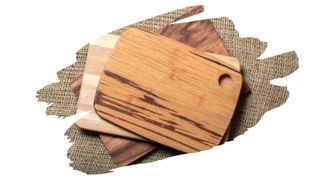When you’re making a decorative cutting board, you have a wide range of different woods to choose from. Everything from the appearance of the grain — to how well that wood takes on wood glue — come to mind.
But, when it comes to making a cutting board that you’ll actually be prepping food on, your choice of wooden materials is a fair bit narrower. This is because food safety is the central and most important consideration when it comes to a food prepping surface.
So, where does that leave Black Walnut? This dark hardwood timber is widely used to make everything from furniture to flooring. Yet, is this lumber also safe enough to prepare your food upon?
Well, in this post you’ll learn why wood is one of the most hygienic types of material you can use. You’ll also find out why Black Walnut wood is classed as a ‘sensitizer’ — and what this means for food safety when it comes to chopping blocks.
And keep reading to discover the best way to treat and seal a Black Walnut cutting board.

This post may contain affiliate links to products that we receive a commission for (at no additional cost to you). Learn more here.
What Type Of Chopping Board Material Is The Most Hygienic?
The best chopping boards are made from material that is both easy to sanitize and durable. That’s why materials such as plastic, bamboo, rubber, and wood, are widely used to make chopping boards.
However, only one of these materials has a natural antibacterial characteristic.
Natural solid wood, (thanks to its water-wicking pores), is a very water-absorbent material. Which is why we often need to seal wood in water-repelling oils and finishes, to help prevent wood rot.
And it is woods hygroscopic nature that makes it antibacterial. Hygroscopy is the scientific term given to the way wood easily absorbs moisture and water vapor.
Now, when we place raw meat atop a wooden surface, wood will fast absorb raw meat juices.
This means that wood naturally draws the bacteria (in those juices) down and away from the surface of that board. And this, in turn, minimizes the chances of cross contamination.
Related Post: Can You Apply Wood Stain To A Cutting Board?
Does That Mean Any Type Of Wood Is A Good Choice For A Chopping Block?
Not exactly. Some types of wood have grain textures that all but cancel out their antibacterial advantage.
You see, wood types with large open pores, (like say Red Oak wood), are difficult to sanitize. That is because raw meat can become snagged up and firmly lodged in those open pores.
So, unless you carefully scrub the surface, (trying to remove every single meat strand), bacteria could grow on that boards surface.
On top of that, some wood types are either too hard or too soft to be used as regular food prepping chopping blocks.
And that’s not to mention the many different poisonous woods out there that are best avoided (like the Yew Tree).
OK. So What Is An Unacceptable Material For Making Cutting Boards With?
As a general rule of thumb, avoid wood that can contaminate your food with toxic or otherwise poisonous compounds.
This means lumber sourced from poisonous trees should be avoided.
Also wood thats been pressure treated with toxic chemicals, should be crossed off your list of possible choices as well.
Related Post: What’s The Difference Between Kiln Dried Wood Vs Pressure Treated Timber?
What About Black Walnut? Is It Toxic?
Well, a chemical compound produced by this tree, called Juglone, certainly is.
The amount of Juglone found in Black Walnuts is toxic to small animals. And if tiny critters were to eat nuts from this tree, it can cause severe respiratory problems in animals.
Now, Juglone is a natural toxin that is produced by the Juglandaceae tree species — a.k.a The Walnut Family.
So, trees such as the Black Walnut, English Walnut, Hickory, and Butternut, all have Juglone saturating them. Which means that everything from their roots and leaves, to their nuts and bark, contain this chemical.
However, Black Walnut trees have the highest amount of Juglone out of the entire Walnut family.
Is Black Walnut Wood Toxic To Humans?
As long as you don’t actually ingest any part of the tree, the amount of Juglone in Black Walnut won’t harm you. However, it’s still concentrated enough to cause allergic reactions in humans.
As a result, Black Walnut wood is classed as a ‘sensitizer’ substance. But, this isn’t uncommon when it comes to working with wood.
For example, sawdust (no matter from which wood species) is also a sensitizer. If you were to inhale sawdust, it can cause nausea and respiratory problems.
However, there are some types of lumber that can cause more severe allergic reactions — even as solid wood.
You see, Juglone is a particular problem for people who are highly sensitive to it.
In these cases, even regularly handling solid Black Walnut can cause them to break out in an itchy rash. This type of allergic reaction is known as ‘contact dermatitis’.
So Is Black Walnut Wood Safe For A Cutting Board?
As long as you don’t ingest the wood, it shouldn’t be a problem using this wood for a cutting board.
However, high sensitivity to Juglone isn’t all that uncommon. So keep that in mind if you plan on gifting someone with a Black Walnut wood cutting board.
But Is Walnut Wood Strong Enough To Be A Cutting Board?
There are different ways to measure the strength of wood. Yet, when it comes to chopping boards, it’s the compressional strength of wood that really matters.
Compressional strength measures how much compressional stress wood can handle before it becomes crushed.

One way that we measure the compressional strength of wood is by using the Janka Hardness Scale. The Janka rating lets us know how much pressure it will take to crush a piece of wood.
However, when it comes to cutting boards, there is such a thing as too hard. Whilst a very tough board will last longer, your kitchen utensils — on the other hand — certainly won’t.
This is why there is an optimal Janka rating range for cutting board wood.
Ideally, chopping board wood should have a Janka rating that falls between 900 lbf and 1500 lbf. Especially if you plan on using that board for regular food prep.
For example, one very popular cutting board wood type is Hard Maple (also known as the Sugar Maple).
This North American hardwood has a Janka rating of 1450 lbf. That means that it will take 1450 pounds of force to crush this timber.
Black Walnut, in comparison, has a Janka rating of 1010 lbf. And this places Black Walnut wood right within the optimal cutting board range.
So, provided you regularly season it, both your board (and your kitchen utensils) should last a good long while.
And How Do You Treat And Season A Black Walnut Cutting Board?
Use 100% pure food grade mineral oil to seal a cutting board.
Food grade mineral oil is a non-drying oil that doesn’t go rancid and doesn’t wash off.
Related Post: Walnut Oil Vs Mineral Oil: Which One’s Better For Your Cutting Board?
Made from highly refined and filtered distilled petroleum, food grade mineral oil is non-toxic. So, if a little of it happens to get into the food your preparing, it won’t make you ill.
But, most importantly, this oil does not go off or mold. This is in stark contrast to a lot of culinary non-drying oils, such as Vegetable oil or Olive oil.
That’s why mineral oil is one of the best (and affordable) ways to seal your cutting board. And all without posing a risk to food safety.
You can find food grade mineral oil on sale at any local pharmacy.
To Wrap Up, Here Are The 3 Key Takeaways From This Post…
- 1). Black Walnut contains high concentrations of a toxin called Juglone. The wood of this tree isn’t harmful to humans unless it’s ingested.
- 2). However, handling raw solid Black Walnut wood can trigger severe allergic reactions in some people.
- 3). You can use Black Walnut to make cutting boards. But, you must treat it regularly with a non-drying wood oil finish, such as Mineral Oil.
References:
Black Walnut: The Killer Tree | IOWA State University
Gambichler, Thilo, Stefanie Boms, and Marcus Freitag. “Contact dermatitis and other skin conditions in instrumental musicians.” BMC dermatology 4.1 (2004): 1-12.



